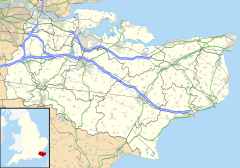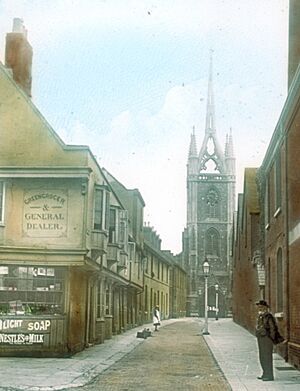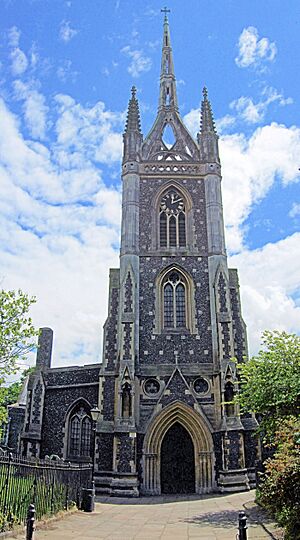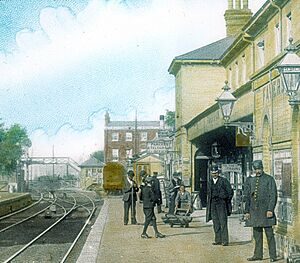Faversham facts for kids
Quick facts for kids Faversham |
|
|---|---|
| Market town | |
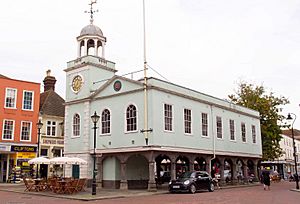 Faversham Guildhall and Market |
|
| Population | 20,936 (2021 Census) |
| OS grid reference | TR015615 |
| • London | 48 miles (77 km) |
| Civil parish |
|
| District | |
| Shire county | |
| Region | |
| Country | England |
| Sovereign state | United Kingdom |
| Post town | FAVERSHAM |
| Postcode district | ME13 |
| Dialling code | 01795 |
| Police | Kent |
| Fire | Kent |
| Ambulance | South East Coast |
| EU Parliament | South East England |
| UK Parliament |
|
| Top - 0-9 A B C D E F G H I J K L M N O P Q R S T U V W X Y Z |
Faversham (pronounced FAY-ver-sham) is a historic market town in Kent, England. It's about 8 miles (13 km) from Sittingbourne and 10 miles (16 km) from Canterbury. The town is located near the Swale, which is a narrow strip of sea separating mainland Kent from the Isle of Sheppey. Faversham is also close to the A2, an ancient road known as Watling Street that was used by Romans and Anglo-Saxons. The town's name comes from Old English, meaning "the metal-worker's village."
People have lived in Faversham since before Roman times, thanks to its old seaport on Faversham Creek. The Saxons lived here, and the town was mentioned in the Domesday Book in 1086. King Stephen liked Faversham and built Faversham Abbey here in 1148. After the abbey closed in 1538, Faversham became an important seaport. It also became famous for brewing beer. The Shepherd Neame Brewery, started in 1698, is still a big employer today.
From the 1600s to the early 1900s, Faversham was a major center for making explosives. This industry declined after a big accident in 1916. Around the same time, shipping became important again. Faversham has many interesting old buildings, including historic churches like St Mary of Charity. The Faversham Market has been running for over 900 years in the town center. The town has good road and train connections, including fast trains to London.
What's in a Name?
The name Faversham was first recorded in 811 as Fefresham. It comes from Old English. The second part, hām, means 'settlement' or 'homestead'. The first part, fæfere, is thought to mean 'smith' or 'metalworker'. This word likely came from the Latin word faber, which also means 'craftsman' or 'smith'. So, Faversham means 'smith's homestead'. It might have even referred to Roman smiths specifically.
A Look Back in Time
Early Days
Faversham was a settlement even before the Romans arrived in Britain. The Romans built several towns in Kent, and Faversham was one of them. Roads from Roman ports like Dover met at Canterbury, then continued to London along Watling Street. Faversham was less than 10 miles (16 km) from Canterbury, so it became part of this road network by 50 AD.
Many Roman building remains have been found in Faversham. Coins and urns were discovered under St Mary of Charity Church in 1794. In 2013, archaeologists found parts of a 2,000-year-old Roman theatre near the town. This outdoor theatre could hold about 12,000 people. It was the first of its kind found in Britain.
There's also proof that Faversham was a summer home for the Saxon kings of Kent. It was a royal estate in 811. King Coenwulf called it 'the King's little town of Fefresham'. In the Domesday Book, it was called Favreshant. By the Middle Ages, Faversham was a busy seaport. It joined the Cinque Ports in the 1200s, which meant it had to provide a ship to Dover for the king.
Medieval Times
Faversham was once a royal estate. King Stephen gave it to his friend, William of Ypres. But then he swapped it so Faversham could be part of Faversham Abbey. King Stephen founded the abbey in 1148. He, his wife Matilda of Boulogne, and his son Eustace were all buried there. Stephen liked the town because of the abbey, making it important during his rule.
Abbey Street was built around this time to create a grand entrance to the abbey. It still has many old timber-framed buildings. People say it's "the finest medieval street in southeast England."
When King Henry VIII closed the monasteries in 1538, Faversham Abbey was given to Thomas Culpeper. Most of the abbey was torn down. It's even rumored that King Stephen's remains were thrown into Faversham Creek. An excavation in 1964 found the graves empty. The abbey's stones were used to strengthen defenses in Calais, France. Only a small part of an outer wall and the entrance gates survived for a while.
Two barns at Abbey Farm are among the few surviving buildings from Faversham Abbey. Minor Barn was built around 1425, and Major Barn, the larger one, in 1476. The Abbey Farmhouse also has parts from the 1300s. The Abbey Guest house, now a private home called Arden's House, is also still standing.
Because roads were poor in the Middle Ages, travel by sea was very important. Richard Tylman, who was mayor in 1581, made the port at Faversham bigger by building two wharfs. He became a key person in sending corn, wheat, and malt from Faversham to London.
Many interesting people from the Middle Ages came from Faversham. Haymo of Faversham became a famous scholar in Paris. Simon of Faversham became the Chancellor of the University of Oxford in 1304. The famous pirate Jack Ward was likely born here around 1553. John Wilson, a musician and teacher, was born in Faversham in 1595. He became a main composer for the King's Men acting group.
Important visitors also came to Faversham. Queen Mary and King Philip visited in 1557. Queen Elizabeth I came in 1573 during a tour of Kent. King Charles II also passed through on his way to be crowned.
Explosives Industry
A gunpowder factory was set up in Faversham around 1573. The town had streams that could power watermills, which were needed for making gunpowder. This factory became known as the Home Works in the 1700s and was taken over by the government in 1759. By the 1800s, the site stretched for about a mile along the waterfront.
Two more explosives factories were built nearby: the Marsh Works in 1786 and another in the late 1600s. By the late 1800s, two new factories were built to make TNT and cordite. From 1874 to 1919, Faversham was the main center for the explosives industry in the UK.
The first production of guncotton happened at the Marsh Works in 1847. An explosion happened soon after, causing several deaths. On April 2, 1916, a large explosion occurred at one of the factories in Uplees. Sparks from a chimney set off about 150 tonnes of explosives. More than 100 people died in this accident. If it hadn't been a Sunday, many more would have been there.
All three gunpowder factories closed in 1934. Production moved to Scotland. Today, the explosives industry is gone from Faversham. The town is now a harbor and market community. Old Thames barges are repaired and kept along the creekside.
Modern Times
Kent is famous for hop-growing, and Faversham has been home to several breweries. The Shepherd Neame Brewery officially started in 1698, but brewing happened in Faversham even before that. It claims to be the oldest brewery in Britain and is still owned by the same family. It makes about 230,000 barrels of beer each year.
A shipyard was built in Faversham in 1916 by James Pollock & Sons. It was asked for by the government to make barges for landing craft. Faversham already had a history of shipbuilding. The shipyard became a major builder of ships for markets worldwide. Over 1200 ships were built and launched from Faversham between 1916 and 1969.
Faversham Market is still held in the town center. It is the oldest street market in Kent, going back over 900 years. Monthly markets are also held on Preston Street and Court Street.
Abbey Street was very important since the 1100s, but it started to decline around the 1900s. Some buildings were torn down in 1892. In the 1950s, much of the street was planned for demolition. But local people fought to save and restore the area.
Archaeological Finds
In May 2019, the Kent Archaeological Field School found a large Roman building at Abbey Farm. This building was 150 by 50 feet (46 by 15 meters). It had stone walls, special tiles for heating the walls, and glazed terracotta floors. There was also an untouched underfloor heating system called a hypocaust. Some walls had white plaster, while a hot sauna room had green, red, and yellow panels.
In 2009, the Faversham Society Archaeology Research Group found proof of the town's medieval tannery. They also found evidence of Anglo-Saxon life between 2005 and 2007.
Where is Faversham?
Faversham is located about halfway between Sittingbourne and Canterbury. It's 48 miles (77 km) southeast of London. Nearby villages include Oare, Luddenham, and Ospringe.
Faversham sits where marshland in the north meets gravel and chalk hills to the south, which lead to the North Downs. Faversham Creek connects the town to the Swale. The area around Faversham is part of the South Swale Nature Reserve, which is a great place for wildfowl and wading birds.
The coastline around Faversham has changed a lot since the last ice age. In Roman times, the Faversham coast was a large estuary. Over time, land was reclaimed, and the estuaries started to fill with silt. Faversham Creek has shrunk a lot. To keep the creek open for boats, several sluices have been built since the 1500s.
Weather in Faversham
Faversham once held the record for the highest temperature ever recorded in the UK. In 2003, it reached 38.5°C (101.3°F). This was the first time the temperature reliably went over 100°F in the UK. This record stood for almost 16 years until it was beaten in Cambridge in 2019. Faversham still holds the record for the highest temperature in the UK for August.
The coldest temperature ever recorded in Faversham was -16.1°C (3.0°F) in January 1966.
| Climate data for Faversham (1991–2020) | |||||||||||||
|---|---|---|---|---|---|---|---|---|---|---|---|---|---|
| Month | Jan | Feb | Mar | Apr | May | Jun | Jul | Aug | Sep | Oct | Nov | Dec | Year |
| Mean daily maximum °C (°F) | 7.9 (46.2) |
8.4 (47.1) |
11.0 (51.8) |
14.2 (57.6) |
17.3 (63.1) |
20.5 (68.9) |
23.1 (73.6) |
23.1 (73.6) |
19.6 (67.3) |
15.4 (59.7) |
11.1 (52.0) |
8.5 (47.3) |
15.1 (59.2) |
| Mean daily minimum °C (°F) | 2.3 (36.1) |
2.2 (36.0) |
3.6 (38.5) |
5.2 (41.4) |
8.0 (46.4) |
10.8 (51.4) |
13.0 (55.4) |
13.1 (55.6) |
10.7 (51.3) |
8.2 (46.8) |
5.0 (41.0) |
2.7 (36.9) |
7.1 (44.8) |
| Average rainfall mm (inches) | 64.4 (2.54) |
50.0 (1.97) |
39.2 (1.54) |
44.6 (1.76) |
49.6 (1.95) |
45.3 (1.78) |
43.3 (1.70) |
57.0 (2.24) |
55.3 (2.18) |
79.9 (3.15) |
74.8 (2.94) |
71.9 (2.83) |
675.3 (26.59) |
| Average rainy days (≥ 1 mm) | 11.6 | 9.5 | 7.4 | 8.4 | 8.0 | 7.5 | 7.2 | 8.1 | 7.8 | 11.5 | 11.2 | 12.1 | 110.2 |
| Mean monthly sunshine hours | 59.1 | 81.1 | 123.2 | 183.5 | 214.3 | 219.0 | 228.1 | 219.2 | 162.3 | 123.7 | 67.7 | 56.3 | 1,737.3 |
| Source: Met Office | |||||||||||||
People of Faversham
In 2011, Faversham had a population of 19,316 people. This was an increase of 1,606 people since the 2001 census. Most of the town's residents (17,868) were born in England. Many people in Faversham work in retail, education, healthcare, construction, and manufacturing.
Culture and Fun

Arden of Feversham is a famous play written around 1590. It might have been written by William Shakespeare or Christopher Marlowe. The modern Arden Theatre in Faversham is named after this play. Local theatre groups perform here as part of the Canterbury Festival every autumn.
The Royal Cinema opened in 1936 and is a Grade II listed building. It's one of only two cinemas in the UK built in a "mock Tudor" style that are still standing.
The Faversham Society started in 1962. It's one of the oldest groups in the UK dedicated to protecting local heritage. They run the Fleur de Lis Heritage Centre, which is their headquarters. The Centre has a large museum about the town's history and culture. It also has the town's Visitor Information Centre and a bookshop.
The Maison Dieu (meaning 'House of God') is located on the A2 road. It was built by King Henry III in 1234. It was once a hospital, monastery, and royal lodge. Now, English Heritage looks after it. It's also a museum that displays Roman artifacts found in the area.
Davington Priory is northwest of the town center. It was founded in the mid-1100s. Today, musician and activist Bob Geldof owns and lives there.
Brogdale Farm, south of the town center, has been home to the National Fruit Collection since 1954. It's like a huge library of fruit! It has over 2,040 kinds of apples, 502 kinds of pears, 350 kinds of plums, and many other fruits. All these are grown in 150 acres (61 hectares) of orchards. The farm hosts fruit festivals, guided tours, and activities for schools. It also has a miniature railway that runs through the orchards.
In 2011, it was discovered that Faversham owns an original version of the Magna Carta. This document is very valuable. In 2015, this copy was shown to the public at the town's Alexander Centre. It was the first time it had been on display for 715 years! The Magna Carta and other town charters are now on permanent display at 12 Market Place in Faversham.
The 2021 Tamil film Jagame Thandhiram was partly filmed in Faversham, including at the Iron Wharf.
In August 2023, a copy of a prayer book written by Katharine Parr was found. It is now on display at the Fleur de Lis Heritage Centre. This is the first book printed in English that was written by a woman.
Local Media
Local news and TV shows for Faversham come from BBC South East and ITV1 Meridian. Radio stations include BBC Radio Kent, Heart South, Gold, KMFM Canterbury, and Radio Faversham, which is a community station. Local newspapers are the Faversham Times, The Faversham News, Eye, and yourswale.
Community Spots
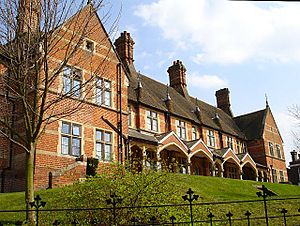
Faversham Recreation Ground, often called Faversham Rec or The Rec, is east of the town center. It was created in 1860 by a local lawyer named Henry Wreight. He left £70,000 and two almshouses (homes for poor people) to the town. He wanted locals to have a place to enjoy. The Rec is still run by the town's Municipal Charities. A bandstand was added in the late 1800s, and sports events started to be held there. A week-long party was held here in 1953 to celebrate the Coronation of Queen Elizabeth II.
The Oare Gunpowder Works is now a country park and nature reserve. It's open to the public for free. The Oare Marshes are an important place for birds. There's an information center near the old ferry crossing to the Isle of Sheppey. You can still see remains of the old factory buildings and water channels. An electric-powered gunpowder mill from the early 1900s has been brought back to the park and is on display. The 18th-century factory bell is also on display at Faversham's Fleur de Lis Heritage Centre. Stonebridge Pond, once part of the Chart Mills, is now a safe place for wading birds.
Famous Places
Faversham Stone Chapel is a very old building in Norton, Buckland and Stone. It's managed by The Faversham Society. This chapel was used for pagan rituals before the Romans came to Britain. It's the only church in Britain that still has evidence of a pagan shrine inside. The building was turned into a church around 601 AD. It hasn't been used as a church since the 1500s.
Even though Faversham Abbey was closed, the nearby St Mary of Charity, Faversham Parish Church is still standing. It has been a Grade I listed building since 1950. King Stephen and Queen Matilda built the church in 1147. It has a unique spire added around 1794-1797 that you can see from many parts of town. The inside was restored in the mid-1800s by architect Sir George Gilbert Scott. The church is said to hold the remains of King Stephen. It also has an altar dedicated to Saints Crispin and Crispinian, who supposedly came to Faversham in the 200s.
St Catherine's Church dates back to the Norman period. It was also restored in the 1860s. The nearby Ospringe Church is also from Norman Britain. The National Shrine of Saint Jude is a Roman Catholic shrine in the Church of Our Lady of Mount Carmel. It opened in 1955 and attracts many Christian visitors.
The Grade II listed St John the Evangelist church on Upper Brents was built in 1881. It was founded by Mrs. Hall, whose husband made gunpowder.
The historic town center, especially the areas between the station and the creek, attracts many visitors. You can learn about the town's history at the Fleur-de-Lis center. There's still a regular market several days a week in the market square, where the Guildhall stands. Nearby streets have old pubs, almshouses, shops, art galleries, and restaurants.
Faversham Cottage Hospital opened in 1887. It was expanded in 1922 and included a World War I memorial. This memorial was later updated to remember World War II casualties. In 2014, it became a Grade II listed building.
Faversham Cemetery opened in 1898. The chapel was designed by Edwin Pover. Many victims of the 1916 gunpowder explosion are buried here. They are remembered by the Grade II* listed Faversham Munitions Explosion Memorial. The Irish writer Kate O'Brien is also buried in the cemetery.
Getting Around Faversham
Faversham is close to the A2 road. This road has been important for a very long time, connecting London to Canterbury and the Channel ports. It started as an ancient path that the Romans later paved. The Anglo-Saxons called it Wæcelinga Stræt (Watling Street). The A2 still carries traffic today, though London-bound traffic now uses the M2 motorway. The A299 Thanet Way goes to the Isle of Thanet. The A251 Ashford Road is a local road to Ashford. The Mall is a main road into the town center from the A2. It was built in the late 1700s.
Faversham railway station opened in 1858. It was completely rebuilt in 1898 and is a Grade II listed building. An old goods shed from the original railway is also listed. Southeastern trains go to London, ending at Victoria or St Pancras. In the other direction, trains go to Dover Priory or Ramsgate. Since 2009, fast trains on High Speed 1 connect Faversham to Ebbsfleet International, Stratford International, and London St Pancras.
Buses also serve the town. Arriva Southern Counties runs service 333 to Sittingbourne. Stagecoach in East Kent operates routes to Canterbury and Ashford. Regent also runs services to Whitstable and other local villages. National Cycle Route 1 passes through Faversham, going from Whitstable to Sittingbourne.
Learning in Faversham
There has been a school in Faversham since the 1100s. By 1420, it was a grammar school. In 1526, John Cole started a new grammar school. After the abbey closed, this school fell into disuse. A new grammar school was set up in 1587. The Wreights School for boys opened in 1856, and The Gibbs School for girls opened in 1883. The two boys' schools joined in 1920 to form Queen Elizabeth's Grammar School. The current school building is from 1967, when the boys' and girls' schools merged. It was the first co-educational grammar school in Kent.
The Abbey School is a Business and Enterprise Academy. It was formed in 1983 by combining two other schools. It has over 1000 students and is located south of the town, near the A2 road.
The Faversham Institute was founded in 1862. It had meeting rooms, halls, and a library. People could study for exams there. The Institute published a monthly magazine until 1919. The building was torn down in 1979.
Faversham Library is part of Kent County Council's library system. The current building on Newton Road opened in February 1973.
Sports in Faversham
Faversham Town F.C. is a football club formed in 1884. They play in Division One South of the Isthmian League. Their stadium, south of town, can hold 2000 people. They are the only team besides the England national football team allowed to wear the three lions badge.
Faversham Ladies Hockey Club plays in Division 6 of the South East Hockey League. They won the Mina-Jones trophy in April 2024. The team plays its home games in Sittingbourne because there isn't an AstroTurf pitch in Faversham.
The King George V playing fields are what's left of the Mount Field. In 1876, a first-class cricket match was played there between Kent and Hampshire County Cricket Club.
Images for kids
-
Faversham Abbey, sketched by William Stukeley in 1722, was established by King Stephen in 1148. He was buried there in 1154.
-
The Maison Dieu sits to the south of the town centre on the A2 and houses artefacts from Roman Britain.
-
Almshouses built using the bequest of Henry Wreight
See also
 In Spanish: Faversham para niños
In Spanish: Faversham para niños


